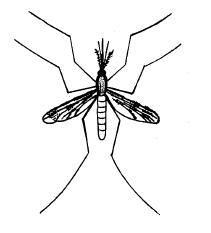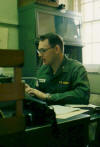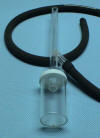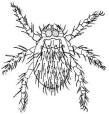|

Military Entomology Research
 Fresh out of Army ROTC in 1966, with a commission in the Army Medical
Service Corps and a masters degree in Entomology
from Utah State University, I was assigned to the Army Environmental Fresh out of Army ROTC in 1966, with a commission in the Army Medical
Service Corps and a masters degree in Entomology
from Utah State University, I was assigned to the Army Environmental
 Hygiene
Agency at Edgewood Arsenal, Maryland, to do entomological research. We
investigated methods of surveying and controlling mosquito populations,
specifically in support of the ongoing Vietnam War. It was there that I
designed a novel "tee-design" aspirator for the collection of insects, like
mosquitoes. Hygiene
Agency at Edgewood Arsenal, Maryland, to do entomological research. We
investigated methods of surveying and controlling mosquito populations,
specifically in support of the ongoing Vietnam War. It was there that I
designed a novel "tee-design" aspirator for the collection of insects, like
mosquitoes.
In 1967 I was sent to Korea, where I served as the Officer in Charge of
the 5th Preventive Medicine Unit Laboratory at Camp Nabors, near Seoul,
Korea . The
laboratory was responsible for assessing the status of arthropod borne
diseases in South Korea, which could impact the effectiveness of military
troops. The laboratory had a network of mosquito light traps throughout
South Korea so we could evaluate the threat of mosquito borne diseases. With the prospect of a 13-month tour of duty in Korea, I set out to find meaningful work
for . The
laboratory was responsible for assessing the status of arthropod borne
diseases in South Korea, which could impact the effectiveness of military
troops. The laboratory had a network of mosquito light traps throughout
South Korea so we could evaluate the threat of mosquito borne diseases. With the prospect of a 13-month tour of duty in Korea, I set out to find meaningful work
for
 myself and others in my command. A
newspaper article (PDF 0.87 MB) was written about the laboratory's work. We decided on an ambitious project to
survey the South Korean peninsula for ectoparasites (fleas, lice, ticks and
mites), which were then suspected of playing a role in Korean Epidemic Hemorrhagic Fever.
That disease had caused many casualties during the Korean War. At the
time of my service there, military hostilities in Korea were relatively quiet and a lot of military resources could be used
in support of our medical research projects. myself and others in my command. A
newspaper article (PDF 0.87 MB) was written about the laboratory's work. We decided on an ambitious project to
survey the South Korean peninsula for ectoparasites (fleas, lice, ticks and
mites), which were then suspected of playing a role in Korean Epidemic Hemorrhagic Fever.
That disease had caused many casualties during the Korean War. At the
time of my service there, military hostilities in Korea were relatively quiet and a lot of military resources could be used
in support of our medical research projects.
Arthropod Borne Diseases in South Korea: Arthropod borne diseases
were a significant health problem during the Korean War. Some, like malaria,
had a dramatic increase as the hostilities broke out. The 5th Preventive
Medicine Unit Laboratory updated a
 locally produced "technical bulletin" on
arthropod diseases in South Korea and published it as the 5th Preventive
Medicine Unit's "Technical
Bulletin No.3" (PDF 0.73 MB). It described the historical and seasonal patterns of
Malaria, Japanese B Encephalitis, Epidemic Hemorrhagic Fever, and Epidemic
Typhus. It also reviewed Relapsing Fever, Filariasis, Scrub Typhus, Plague,
Dengue Fever, "Filth Diseases" (including typhoid and dysentery),
Paragonimiasis (oriental lung fluke), dipylidiasis (tapeworm), and Heartworm
of Dogs. To cope with these diseases, the 5th Preventive Medicine Unit
Laboratory gathered data about mosquitoes, other insects, and other
arthropods, and disseminated its findings to medical officers in the 65th
Medical Group, 8th Army, in South
Korea. locally produced "technical bulletin" on
arthropod diseases in South Korea and published it as the 5th Preventive
Medicine Unit's "Technical
Bulletin No.3" (PDF 0.73 MB). It described the historical and seasonal patterns of
Malaria, Japanese B Encephalitis, Epidemic Hemorrhagic Fever, and Epidemic
Typhus. It also reviewed Relapsing Fever, Filariasis, Scrub Typhus, Plague,
Dengue Fever, "Filth Diseases" (including typhoid and dysentery),
Paragonimiasis (oriental lung fluke), dipylidiasis (tapeworm), and Heartworm
of Dogs. To cope with these diseases, the 5th Preventive Medicine Unit
Laboratory gathered data about mosquitoes, other insects, and other
arthropods, and disseminated its findings to medical officers in the 65th
Medical Group, 8th Army, in South
Korea.
South Korean Mosquito Report: During 1967, more mosquitoes were
collected by the 5th Preventive Medicine Unit Laboratory than any previous
year. Surveying mosquito populations began in 1959. By 1962 an extensive
network of mosquito light traps had been established throughout South Korea.
Standard "New Jersey" light traps were placed at military
 installations,
usually connected to security lighting systems. Trapped mosquitoes were
collected, boxed and shipped to the laboratory by local military personnel.
Korean entomologists at the laboratory would sort the mosquitoes by species,
count them, and record the data. These data, together with data from
previous years, were compiled into a six-year mosquito survey report,
1962-1967 (PDF 3.0 MB). The report includes a map of South Korea, showing where the
mosquito light traps were located, graphs and tables of the seasonal
prevalence of each species, and annual summaries of species collected for
each light trap throughout South Korea. installations,
usually connected to security lighting systems. Trapped mosquitoes were
collected, boxed and shipped to the laboratory by local military personnel.
Korean entomologists at the laboratory would sort the mosquitoes by species,
count them, and record the data. These data, together with data from
previous years, were compiled into a six-year mosquito survey report,
1962-1967 (PDF 3.0 MB). The report includes a map of South Korea, showing where the
mosquito light traps were located, graphs and tables of the seasonal
prevalence of each species, and annual summaries of species collected for
each light trap throughout South Korea.
Ectoparasite Survey of South Korea: Soon after arriving in Korea,
I arranged to visit the
 406th Medical Laboratory in Japan, where I met with
entomologist LTC Vernon J. Tipton and virologist Captain Ned Wiebenga. We
discussed how little was known about Korean epidemic hemorrhagic fever. 406th Medical Laboratory in Japan, where I met with
entomologist LTC Vernon J. Tipton and virologist Captain Ned Wiebenga. We
discussed how little was known about Korean epidemic hemorrhagic fever.
 We
decided that a survey of the ectoparasites of South Korea would be valuable
contribution to the research. Back in Korea, I gathered my laboratory staff
for a strategy session. On a large map of South Korea, we marked a sequences
of sampling locations where we might collect rodents. Then we sought and
received support for the medical research project from 8th Army
headquarters. We
decided that a survey of the ectoparasites of South Korea would be valuable
contribution to the research. Back in Korea, I gathered my laboratory staff
for a strategy session. On a large map of South Korea, we marked a sequences
of sampling locations where we might collect rodents. Then we sought and
received support for the medical research project from 8th Army
headquarters.
We used a laboratory van (mounted on a 2 1/2 ton truck) and a jeep with a
small trailer to transport a survey team of four men from one designated
survey site to the next. I would select the next survey site from a
detailed topographic map and then take a member of the next survey team in a
OH-23 helicopter to evaluate the site and the roads to get there. At first
the teams drove to the survey sites and then drove back to the lab with the
specimens that they collected at the end of the week. Later, as the survey
sites became more distant from Camp Nabors, we started using a
UH-21
(banana-shaped) helicopter site to the next. I would select the next survey site from a
detailed topographic map and then take a member of the next survey team in a
OH-23 helicopter to evaluate the site and the roads to get there. At first
the teams drove to the survey sites and then drove back to the lab with the
specimens that they collected at the end of the week. Later, as the survey
sites became more distant from Camp Nabors, we started using a
UH-21
(banana-shaped) helicopter to transport the next survey team (together with
a supply of food and fuel) to the current survey site, picking up the old
survey team and their rodent specimens for transport back to the Camp Nabors
laboratory, and sending the new survey team off by road to the next survey
site. I would usually use a OH-23 helicopter to check on the survey team
about the mid-point of their survey to pick up frozen rodent specimens and
to check on their progress. to transport the next survey team (together with
a supply of food and fuel) to the current survey site, picking up the old
survey team and their rodent specimens for transport back to the Camp Nabors
laboratory, and sending the new survey team off by road to the next survey
site. I would usually use a OH-23 helicopter to check on the survey team
about the mid-point of their survey to pick up frozen rodent specimens and
to check on their progress.
 Then each rodent specimen was given an
identification number and processed in the laboratory by
Korean
entomologists. Ectoparasites were combed from the rodents, mounted on
microscope slides, and identified taxonomically. Rodent skulls and skins
were preserved for future taxonomic reference. Then each rodent specimen was given an
identification number and processed in the laboratory by
Korean
entomologists. Ectoparasites were combed from the rodents, mounted on
microscope slides, and identified taxonomically. Rodent skulls and skins
were preserved for future taxonomic reference.
One of the locations we wanted to survey was the island of Cheju, which
is located off the southwestern tip of the Korean peninsula. When the survey
team got
 to Pusan, we arranged to have the Korean Navy load our survey
vehicles onto
LSM 613, a landing ship with a ramp. It was a tight squeeze,
but we got them and the survey vehicles on board and shipped them off to Cheju
Island. It took three days to get to the island and they had trouble getting
the vehicles through the sand on the beach. The U.S. Air Force provided a
cargo plane to take a new survey team to the island and pick up the old
team. The island survey yielded several unusual species of animals. Then, on
January 22, 1968, military tensions ran high as word of 31 communist
infiltrators arrived in a classified message. The next day a secret-flash
message alerted us that the North Koreans had to Pusan, we arranged to have the Korean Navy load our survey
vehicles onto
LSM 613, a landing ship with a ramp. It was a tight squeeze,
but we got them and the survey vehicles on board and shipped them off to Cheju
Island. It took three days to get to the island and they had trouble getting
the vehicles through the sand on the beach. The U.S. Air Force provided a
cargo plane to take a new survey team to the island and pick up the old
team. The island survey yielded several unusual species of animals. Then, on
January 22, 1968, military tensions ran high as word of 31 communist
infiltrators arrived in a classified message. The next day a secret-flash
message alerted us that the North Koreans had
 captured a U.S. vessel
(USS
Pueblo) in international waters. Suddenly, the support for our medical
research project dropped. The Air Force was too busy to transport us. The
Korean Navy landing ship, which was scheduled to pick up our survey
vehicles, had been diverted. We were stranded on the island of Cheju. The
tension did not escalate, so in a few more days we finally got our survey
team and vehicles back. The next five months were spent processing specimens
and preparing the data for publication. captured a U.S. vessel
(USS
Pueblo) in international waters. Suddenly, the support for our medical
research project dropped. The Air Force was too busy to transport us. The
Korean Navy landing ship, which was scheduled to pick up our survey
vehicles, had been diverted. We were stranded on the island of Cheju. The
tension did not escalate, so in a few more days we finally got our survey
team and vehicles back. The next five months were spent processing specimens
and preparing the data for publication.
Towards the end of my tour of duty in Korea, we sent our survey team and
vehicles back
to Cheju to collect more specimens and to support a Korean entomologist, Dr.
Kim, in her filarisis research on the island.
duty in Korea, we sent our survey team and
vehicles back
to Cheju to collect more specimens and to support a Korean entomologist, Dr.
Kim, in her filarisis research on the island.
The
"Ectoparasite Survey of South Korea"
(PDF 11.2 MB) report was designed to preserve
a record of the ectoparasite species, host species, and collection locations
for future reference by subsequent researchers. It shows a map of survey
locations in South Korea, a checklist of ectoparasites by host, and
taxonomic keys to mites and sucking lice. The bulk of the report is a
listing of each ectoparasite species found, showing the specific host
animal, date of collection, locality and grid coordinates of collection
site, the collector, and number of parasites for that specific host animal.
The value of our work was recognized in a
Letter of
Appreciation from the Surgeon General of the Republic of Korea Navy and
a U.S. Army
Commendation Medal.
In August, 2009, Dr. Pyong Ui Roh, emailed me to explain that after I left
Korea, Camp Nabors was closed down. The 5th Preventive Medicine Unit was
relocated to Ascom, near Inchon where it occupied the old 121st Evacuation
Hospital buildings. "We had a wonderful space and facilities.... All
members moved to Ascom area, but unfortunately one night the buildings of
old 121 hospital were burnt down. We lost all specimens, books and
equipment. Every body cried because of the loss of the treasure we had
accumulated," said Dr. Roh. The Unit's
headquarters and survey team moved to Camp Red Clouds, in Ui Jongbu (Camp
Mosier?).
Later, in 1972,
Stan Malcolm took charge of the 5th Preventive Medicine Unit Laboratory,
"just [as it was] starting to recover from a fire that destroyed much of the
unit's materials and equipment."
[Top]
[Home]
|